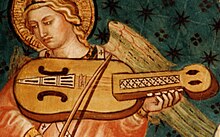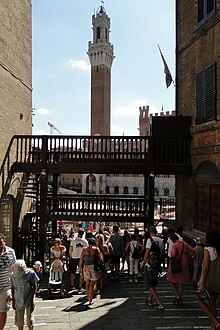Palazzo Pubblico (Siena)
The Palazzo Pubblico (Palazzo Comunale, City Hall ) is a palace in Siena , in Tuscany in Italy , construction of which began in 1297 as the seat of the Republican Government , the Podesta and the Council of Nine .
The palace is centrally located on Siena's former market square , the Piazza del Campo , where the Palio , an annual local horse race, takes place. In the palace itself, which now houses the city museum, there are numerous famous frescoes, such as the one shown by Guidoriccio da Fogliano in the room of the maps (Sala del Mappamondo). The fresco is probably by Simone Martini . The wall of the room shows the remains of the no longer existing drawing of a world map by Ambrogio Lorenzetti . One of the most famous works in the palace is the depiction of the good and bad government in the Hall of the Nine (Sala della Pace, Sala dei Novi) by Ambrogio Lorenzetti.
Originally the palazzo only had three floors; later there were further extensions. Above all, however, the Torre del Mangia , the 102 meter high tower, was added in the course of the 14th century , which characterizes the cityscape of Siena. The name is derived from the nickname Mangiaguadagni ( income eater - from Italian mangiare = (fr) eat) of the first bell ringer (Giovanni di Duccio).
The historic center of Siena with the Palazzo has been a UNESCO World Heritage Site in Italy since 1995 .
Building history
Documents from that time prove that the first attempts at building the palace date back to 1250.
In 1299 the entire central wing was completed and in 1305 the construction of the two side wings began. The building was completed in 1310 and remained so until 1680. In that year additions and an increase were made, the same thing happened at the beginning of the 18th century.
The lower part of the main facade consists of masonry made of natural stone, which is decorated with characteristic Senesian arches. The brickwork on the second and third floors shows two rows of pointed three-arched windows, and the fourth floor of the central structure is adorned with a wreath of delicate battlements and arches. Between the two-arched windows on this floor there is a large copper plate with the monogram of Christ , the symbol of St. Bernardine , which is flanked by two stone wolves at the corners of the building.
The tower of the palace ( Torre del Mangia ) was built between 1325 and 1344, its top was designed by Lippo Memmi . Under the direction of Giovanni D'Agostino , a brick shaft was built up by two brothers from Arezzo from 1338 to 1348 . The travertine crown shows the two city coats of arms of the municipality, in the center a leaping lion, and above it the bell house was built in 1341 based on a drawing by Lippo Memmi . In the upper belfry hangs the large bell , cast in 1665 , which is called Campone or Sunto because it is dedicated to the Assumption of Mary (Italian: Assunta ). Until 1780 there was an automaton at the top that struck the hours.
The chapel ( Cappella di Piazza ) below the Torre del Mangia was built in fulfillment of a solemn promise made by the people of Siena during the plague of 1348. Construction began in 1352 by Domenico d'Agostino , but it was not completed until 1376 by Giovanni di Cecco (design of the pillars and roof). The roof structure was built by Antonio Federighi from 1461 to 1468 .
The courtyard of the palace, called Courtyard of the Podesta , was built from bricks in 1325 and restored in 1929. It consists of an arcade with one storey above it, which is adorned by large three-arched windows. The coats of arms of mayors can be seen on the walls, as well as a 14th century fresco depicting Our Lady with two angels . A statue of Mangia and the she- wolf who breastfeeds the twins (symbol of the city's history), as well as a gilded tin statue of Giovanni di Turino (1429–1430) are in the vestibule and at the end of the portico.
inside rooms
The map room ( Sala del Mappamondo ) was named after a map of the world painted by Ambrogio Lorenzetti , which can no longer be seen today. It is located on the first floor of the palace. Two world-famous frescoes by Simone Martini are located opposite one another on the walls . The maesta ( Madonna enthroned ), created around 1315, is considered to be the oldest fresco in Siena. It is made in the French Gothic style , in combination with the Hellenistic and Italian painting style adopted by Duccio . It fascinates with the light brushstroke, the precious lively blue and gold colors, as well as the execution of the smallest details. The fresco on the opposite side shows Guidoriccio da Fogliano on horseback, defeating the lords of Montemassi and Sassofortino , who rose against Siena, is just as famous. It was completed in 1329. It is considered the most successful work by Simone Martini.
In the Room of Peace (or Room of the Nine ) ( Sala della Pace or Sala dei Nove ) you can see the frescoes by Ambrogio Lorenzetti, painted between 1337 and 1339. The fresco cycle shows the allegory of the good and the bad government , the effects of the type of rule on the population in town and country in three picture units, which are combined into one work. The good government consists of an aged king, solemnly dressed in black and white. They are the colors of the balzana , the banner and the coat of arms of the city. The king embodies the common good. On his left are the personifications of justice , moderation - the hourglass in her hand is the earliest evidence of their use - and generosity ; on his right are wisdom, strength, and peace. Faith, love and hope float in the air, at the lower edge of the picture the she-wolf suckles Aschius and Senius, sons of Remus and mythical founders of the city of Siena. The Impact of Good Government on the City shows a cityscape in which there is cheerful, peaceful goings-on, the Impact of Good Government on the countryside shows blooming and fertile fields, forests and groves with dancers. The Bad Government depicts a ruler with devil attributes surrounded by hellhounds and personifications of deadly sins and vices .
The cycle of frescoes of the good and bad government is a key work of European painting, not only because of the formal spatial representation of the figures as well as the landscape, but because it reflects the educational standard of some educated circles of this early humanist period. It becomes clear that at this time, long before Petrarch, there was already in-depth knowledge of Homer's epics and even knowledge of Hesiod's work in Western Europe.
As the latest image analyzes have shown, the conception of the fresco cycle Good and Bad Government was based on already existing pictorial material, obviously starting with Homer's description of the shield (Homer, Iliad , Canto 18) as well as Hesiod's description of the shield (Hesiod, The Shield of Heracles ). In addition, further research showed that there were already existing, fictional image ideas with some other authors, such as with Plato , Cicero , Augustine , Thomas Aquinas as well as in Seuse's mystical visions, which found their way into Lorenzetti's picture cycle.

A marble altar can be seen in the (inner) chapel of the Palazzo Pubblico , above there are paintings of Sodoma with the Holy Family and St. Leonhard , the side vaults are painted with frescoes by Taddeo di Bartolo (around 1407), which show the Evangelists , Doctors of the Church , various prophets and scenes from the life of the Holy Virgin . The choir stalls are artistically carved, they were made by Domenico di Niccolò from 1415 to 1428.
The room di Balia , in which the Magistrate of Balia held its meetings, shows frescoes by the Senese painter Martino di Bartolomeo . On the one hand, personifications of virtues are shown, as well as the evangelists and busts of emperors and warriors. A comprehensive fresco cycle in this room, however, comes from Spinello Aretino from Arezzo , who the deeds of Pope Alexander III. shows who defeated Friedrich Barbarossa .
In the pillar hall there are altar panels showing Saint Bernardine of Siena , once as he preaches in the field and once how Genutia is freed from the devil during his funeral. The paintings are by Neroccio di Bartholomeo di Benedetto de 'Landi , from the middle of the 15th century (exact date of creation unknown). The tablets were not brought into the palace until the 19th century.
literature
- Patrick Boucheron: Banished fear. Siena 1338. Essay on the political power of images. Übers. Sarah Heurtier, Sebastian Wilde. Wolff, Berlin 2017. With 15 ills.
Web links
Individual evidence
- ↑ La millenaria storia del mercato di Siena: Il commercio ambulante da Piazza del Campo a Viale XXV Aprile , Edizioni Cantagalli, Siena 2010
- ^ Frugoni, Chiara (1988), Pietro et Ambrogio Lorenzetti , New York, NY: Scala Books, page 83, ISBN 0935748806
- ↑ Michael Kühr: Ambrogio Lorenzetti: Good and bad government. A vision of peace. Images and thoughts from Homer to Dante. A cycle of frescoes in the Palazzo Pubblico in Siena , Mandelbachtal 2002, ISBN 3-00-010833-5
- ↑ 210 pp. - From the French Conjurer la peur , large format (height 25.5 cm), with 288 pages, over 100 ills. Coll. Histoire HC (for "Hardcover", but a flap cover) Seuil, Paris 2013 ISBN 2021134997 ; Paperback: coll.Points histoire, height 18 cm, ibid. 2015 ISBN 2757852809 . - Boucheron is invited to be a member of the delegation for the "guest country France" as a representative at the Frankfurt Book Fair 2017.
Coordinates: 43 ° 19 ′ 6.3 " N , 11 ° 19 ′ 53.2" E




